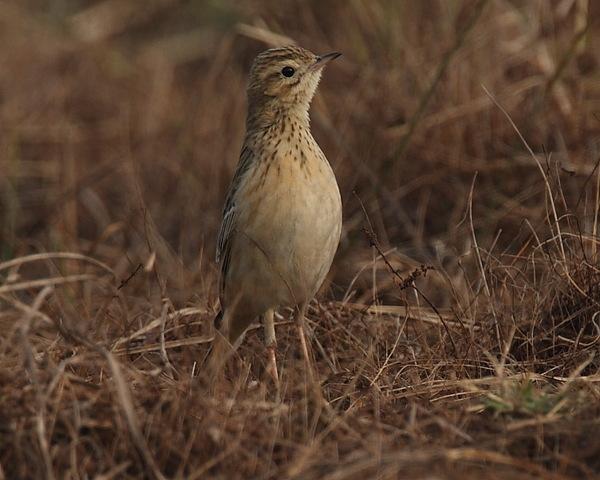Krys Kazmierczak and I saw a couple of large, heavily-streaked Pipits in
the grassland behind Sultanpur on the 2nd of January. We weren't able to
get good scope views, but we saw (and heard) enough to be sure they were
not Paddyfield Pipits; given the Richard's Pipit sightings only a week
before, we concluded that these must be the same species.
I still had some doubts, however, because the birds didn't look as large
in flight or on the ground, and the fine dark streaks on the breast were
more well-defined (besides the habitat being so different). Since I had
not managed a good look at them, I returned to Sultanpur with my friend
Ram (on his first birding trip around Delhi) and Sharad Sridhar.
Indeed, the birds at Sultanpur turned out to be Blyth's Pipits Anthus
godlewskii, another species of which there are few reliable records
from North India. Sharad was able to get some excellent photographs with
his new camera.

My field impression of these birds was very different from the Richard's
Pipits at Dadri. These birds were distinctly smaller in flight, and not
much bigger on the ground than the many Tawny Pipits nearby. They had a
less heavy way of moving (but they were not in the sort of high grass
that I saw the Richard's Pipits in), and though they did pop into an
erect posture sometimes, they looked short-tailed when doing so.
They were also a less intense brown above, but the dark streaking on the
back contrasted more with the paler channels in between. The pale edges
of the wing feathers also contrasted more with the rest of the wing. (We
even saw the squarish dark centres of the median coverts, the classic id
feature for adult Blyth's). The crown was also distinctly streaked. The
pale lores were obvious, but the malar stripe was not always as distinct
(though I see a dark submoustachial stripe in photos). Some of the birds
had shorter beaks (as in the photo) than others, but all had a similar
very sharp-looking conical shape.
The calls were similar to the Richard's Pipits' calls, but were a softer
and more squeaky PReeep. They were also sometimes followed by a
quick chup chup when the bird landed after calling in flight.
One other notable sighting at the Sultanpur flats was of three Eurasian
Skylarks Alauda arvensis. I thought they were Bimaculated Larks
at first, because they were so much larger than the Greater Short-toed
Larks flying nearby, but I then saw the prominent white outer rectrices
and trailing edges to the wings and the streaked breast, and also heard
the distinctive liquid warbling chirrrup call in flight.
What an excellent winter we're having.